Study of Heavy Metals Concentration in Sewage Water of Different Areas Around Bikaner City
Anuradha Aseri* and Sushma Jain
Department of Chemistry, Government Dungar College, Bikaner - 334 003 (India), D-1-133 Vallabh garden, Sudarshana nagar, Bikaner.
Corresponding Author E-mail: aaanu04@gmail.com
DOI : http://dx.doi.org/10.13005/ojc/350428
Article Received on : 08-07-2019
Article Accepted on : 26-08-2019
Article Published : 28 Aug 2019
In this study the concentrations of Cd, Cr , Ni, As and Pb in sewage water have been investigated. Sewage water is used to irrigate vegetable farmlands at Chandmal baag, Sujandesar, Kadari colony (Shriramsar), Kocharo ka bhaththa (Gangashahar-Bhinasar) and Gharsisar areas around Bikaner city. Plants and crops growing here are suffering from many physiological disorders due to use of sewage water. For assesment of heavy metals 28 samples were collected. From the results it was found that the heavy metals concentration in sewage water samples have excess in range than permissible value. So it is important to follow more effective methods of sewage water management to minimize the accumulation of pollutants.
KEYWORDS:Contamination; Health; Heavy Metals; Sewage Water; Toxicity
Download this article as:| Copy the following to cite this article: Aseri A, Jain S. Study of Heavy Metals Concentration in Sewage Water of Different Areas Around Bikaner City. Orient J Chem 2019;35(4). |
| Copy the following to cite this URL: Aseri A, Jain S. Study of Heavy Metals Concentration in Sewage Water of Different Areas Around Bikaner City. Orient J Chem 2019;35(4). Available from: http://www.orientjchem.org/?p=59339 |
Introduction
The lack of quality freshwater resources, many countries in the arid and semi-arid regions use marginal quality water for irrigation. The sewage water is being used for irrigation because it is very rich source of nutrients which improves many properties of soil 1. Vegetables and fodder crops grown by sewage water irrigation are consumed by human beings. Raw Sewage is a rich source of organic and inorganic nutrients for plant growth; in India sewage irrigation is very common in all urban areas. Sewage water irrigation causes contamination of metals in soils, because it may contain many heavy metals like Fe, Zn, Cu, Mn, Cd, Cr, Ni, As and Pb. Heavy metals like Pb, Cd, Hg and As don’t have any lucrative effect on living beings so regarded as the “main threats” because they are very inimical for plants and animals. Such polluting elements are toxic for environment and human beings. As metals cannot be broken down, when concentrations of these metals crossed maximum limits, they badly affect plants. Due to high metal concentration many hazardous effects occurs like cytoplasmic enzymes inhibition, cell structures damage and essential nutrients replacement. Plant growth decreases due to these effects and causes death of plant 2. Few metals can bioaccumulate in cells of animals and human by transferring to food chain thus is very harmful 3-5. Agricultural use of sewage water has many health problems for living beings. Longterm irrigation with sewage water leads to heavy metals accumulation in edable parts of plants 6-8. Heavy metals contaminated food consumption can cause a decrease in immunity, uterus growth inhibition, psycho-social behavior vulnerability, malnourishment disabilities and gastro-intestinal cancer 9.
Thus analysis of irrigated water is very essential. This study is planned to analyse, the level of heavy metals in sewage water of different areas around Bikaner city before mansoon in year 2016. Chandmal baag, Sujandesar, Kadari colony (Shriramsar), Kocharo ka bhaththa (Gangashahar-Bhinasar) and Gharsisar areas of Bikaner city are salient vegetables producer places and these vegetables are bought in whole city. Vegetables and fruits grown at these places have many physiological disorders like leaves cracking, chlorosis, uneven sized fruits, diesel soaked appearance of leaves and branch out of unripened fruits. Therefor these sites have been choosen for the study.
Materials and Method
For the analysis of heavy metals in sewage water, 28 samples were collected in broad–mouth plastic bottles. Out of these 28 samples 8 samples are of Chandmal baag ( 1 to 8), 4 are of Sujandesar ( 9 to 12), 5 are of Kadari colony (Shriramsar) ( 13 to 17), 7 are of Kocharo ka bhaththa (Gangashahar-Bhinasar) ( 18 to 24) and 4 are of Gharsisar ( 25 to 28). All samples of sewage water were filtered prior to analysis.
The filtrate were analyzed for heavy metals. Cd, Cr, Ni, As and Pb were estimated by using acid digestion and measured by Atomic Absorption Spectrophotometer method as described by APHA (1985). The heavy metals in sewage samples were analyzed by the method known as wet-dry ashing. By this method before estimation in Atomic Absorption Spectrophotometer, samples were allowed to settle down for at least 18 hours before the liquid phase was decanted for subsequent analysis. The sewage samples were filtered by Whatman Filter paper No. 42 for estimation of environment available heavy metal and meanwhile 50 ml of each sample 1g (air dried) were digested in 250 ml conical flask with Nitric acid and Perchloric acid in 3:1 ratio. After proper digestion white fume produced in samples then diluted with de-ionized water to leach all metals, and then rinsed three times in H2O. Filtered with Whatman Filter paper No. 42 and then volume was made up to 50 ml in volumetric flask. Heavy metal was estimated by Atomic Absorption Spectroscopy 10.
Result and Discussion
Heavy metals are exceeding the sufficient or normal status.
Table 1: Heavy metals concentration in sewage water (mg/l)
|
Areas |
Sample |
mg/l |
||||
|
Cd |
Cr |
Ni |
As |
Pb |
||
|
Chandmal Baag |
1 |
0.90 | 0.49 | 0.20 | 0.06 | 1.0 |
| 2 | 0.70 | 0.97 | 0.19 | 0.06 |
0.91 |
|
|
3 |
0.65 | 0.97 | 0.15 | 0.05 | 0.89 | |
| 4 | 0.40 | 0.98 | 0.14 | 0.05 |
0.60 |
|
|
5 |
0.03 | 0.05 | 0.13 | 0.05 | 0.50 | |
| 6 | 0.50 | 0.60 | 0.18 | 0.05 |
0.91 |
|
|
7 |
0.40 | 0.54 | 0.18 | 0.05 | 0.75 | |
| 8 | 0.37 | 0.51 | 0.15 | 0.05 |
0.71 |
|
|
Sujandesar |
9 | 2.50 | 0.98 | 0.28 | 0.07 | 1.20 |
|
10 |
2.41 | 0.97 | 0.25 | 0.07 |
0.90 |
|
|
11 |
2.39 | 0.87 | 0.21 | 0.07 |
0.84 |
|
| 12 | 2.30 | 0.75 | 0.20 | 0.07 |
0.61 |
|
|
Kadari colony (Shriramsar) |
13 |
3.10 | 2.40 | 0.37 | 0.07 | 1.51 |
| 14 | 3.00 | 2.40 | 0.35 | 0.07 |
1.17 |
|
|
15 |
2.90 |
2.20 | 0.34 | 0.07 |
1.12 |
|
|
16 |
2.80 | 2.20 | 0.35 | 0.07 |
1.00 |
|
|
17 |
3.30 |
2.50 | 0.40 | 0.08 |
1.77 |
|
|
Kocharo ka bhaththa (Gangashahar-Bhinasar) |
18 |
0.80 | 1.80 | 0.29 | 0.06 |
1.60 |
|
19 |
0.77 | 1.70 | 0.27 | 0.06 |
1.54 |
|
|
20 |
0.74 | 1.70 | 0.24 | 0.07 | 1.40 | |
| 21 | 0.70 | 1.60 | 0.28 | 0.07 |
1.10 |
|
|
22 |
0.79 | 1.79 | 0.27 | 0.07 | 1.52 | |
| 23 | 0.76 | 1.69 | 0.21 | 0.07 |
1.45 |
|
|
24 |
0.50 | 1.45 | 0.20 | 0.07 |
1.30 |
|
|
Gharsisar |
25 |
1.90 | 2.10 | 0.31 | 0.07 |
1.61 |
| 26 | 1.81 | 2.00 | 0.30 | 0.07 | 1.58 | |
| 27 | 1.71 | 1.81 | 0.24 | 0.07 | 1.49 | |
| 28 | 1.70 | 1.79 | 0.22 | 0.07 | 1.30 | |
Cd
The standard permissible limit of Cd for irrigation water is 0.01 mg/l 11. The amount of Cd in all sewage water samples ranges from 0.03 to 3.30 mg/l. Out of 8 samples collected from Chandmal baag area, sample 1 has the highest and sample 5 has the lowest value. Four samples (9 to 12) are collected from Sujandesar area, out of which sample 9 has the highest and sample 12 has the lowest value of Cd. From the results it has been found that samples of Kadari colony (Shriramsar) have very high value of Cd, ranges from 2.80 to 3.30. It is perhaps due to a dying factory is situated in this area. It drains all effluent nearby sewage naala. Samples from Kocharo ka bhaththa (Gangashahar-Bhinasar) have low value of Cd but higher than permissible limit. From Gharsisar area, sample 28 has the highest and sample 25 has the lowest value of Cd. From the results, it has been found that all the samples are not suitable for irrigation. High amount of Cd content in soil results growth retardation, root tips browning, chlorosis and finally death of plant 2. Once entered in body Cd accumulates in human body and retain in body for lifetime. Cd is very harmful for kidney and cause demineralization of bones 12.
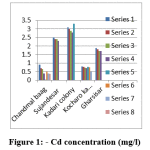 |
Figure 1: Cd concentration (mg/l) Click here to view figure |
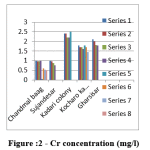 |
Figure 2: Cr concentration (mg/l) Click here to view figure |
Cr
For irrigation purpose the standard permissible limit of Cr is 0.10 mg/l 11. The range of Cr content in all 5 areas’s samples is 0.05 to 2.50 mg/l. Out of 5 areas, Chandmal baag area has the lowest value of Cr. 8 samples are collected from this area, in which 7 are higher than permissible limit. Sample 5’s Cr content is 0.05 mg/l, which is lower than the permissible limit. From Sujandesar area, four samples (9 to 12) are collected. Sample 9 has the highest and sample 12 has the lowest value. 13 to 17, five samples are collected from Kadari colony (Shriramsar). From this area all water samples have the highest value of Cr and their range is 2.20 to 2.50 mg/l. From Kocharo ka bhaththa (Gangashahar-Bhinasar) area’s samples, the content of Cr of sample 18 has the highest and sample 24 has the lowest. Samples (25 to 28) collected from Gharsisar area have also very high value of Cr but lower than Kadari colony area’s samples. Results show that out of 28 samples 27 samples have higher Cr content than permissible limit so all these 27 sewage water samples are not suitable for irrigation. Only sample 5 is suitable for irrigation. The excessive amount of Cr is toxic for plants and humans. Chromium causes cell membranes damage, growth retardation, prevention of seed germination, photosynthetic pigments degradation and reduce weight in plants 2. In humans the most important toxic effects of Cr are allergy, ulcer, asthma, skin eczema, dermatitis, lung and liver cancer.
Ni
It is an important plant nutrient. But the content of Ni requires in very low amount for normal plant growth 2. Maximum permissible limit of Ni in irrigation water is 0.20 mg/l 13. Chandmal baag area’s samples have the lowest value of Ni. Their range is 0.13 to 0.20 mg/l. It has been found that all samples of this area are below from permissible level. Out of four (9 to 12) samples collected from Sujandesar area, 3 samples have high value of Ni. Samples 12’s Ni content is in the permissible limit. All 5 (13 to 17) samples which are collected from Kadari colony (Shriramsar) have the highest value of Ni, their range is 0.34 to 0.40 mg/l. Sample 17 has the highest amount of Ni. Its high value may be due to contamination of dye factory’s water. 6 samples (18 to 23) from Kocharo ka bhaththa (Gangashahar-Bhinasar) area are higher than permissible level and sample 24 has permissible value of Ni. All four samples (25 to 28) from Gharsisar area have high value of Ni.Sample 25 has the highest and sample 28 has the lowest Ni content from this area. The study shows that out of 28 samples 18 samples have higher value than permissible level, hence these are not suitable for irrigation. Chandmal baag area’s all sample are suitable for irrigation in case of Ni. Hence Nickel is essential for plants, high content of Ni in soil is hazardous. Excessive amount of Ni causes root and shoot growth inhibition, prevention of seed germination, spotting of leaf, chlorosis and deformation of shape of flower and parts of plants. High Ni content also affects absorption of nutrients, transpiration and photosynthetic process inhibition 14. Ni ingestion is also harmful for human beings. Excess amount of Ni causes allergy, lung and nasal cancer and many kidney and heart diseases 15.
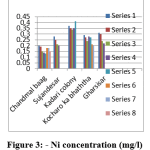 |
Figure 3: Ni concentration (mg/l) Click here to view figure |
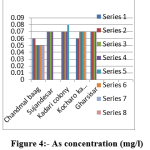 |
Figure 4: As concentration (mg/l) Click here to view figure |
As
The amount of As in sewage water samples does not vary too much. The standard permissible limit of As in irrigation water is 0.01mg/l. The range of As in water samples is 0.05 to 0.08 mg/l. Chandmal baag area’s samples have the lowest value of As still not suitable for irrigation because of higher value than the permissible level. From Sujandesar and Gharsisar area, all samples have 0.07 mg/l As content. Four samples (13 to 16) out of five samples from Kadari colony (Shriramsar) also have 0.07 As content and sample 17 has the highest value of As (0.08 mg/l).Samples collected from Kocharo ka bhaththa (Gangashahar-Bhinasar) area are also higher than permissible value. The results show that all samples are from higher side so none of these sample is suitable for irrigation. Arsenic reduces fruit yield, seed germination, decreases the leaf fresh weight, seedling height and dry matter production 2. WHO reported that excess amount of As causes kidney, skin, bladder and lung cancer. Ingestion of arsenic is very harmful and causes disturbance of heart, central nervous system and gastrointestine which results in death.
Pb
In all 28 samples Pb content range is 0.50 to 1.77 mg/l. The standard permissible limit of Pb in irrigation water is 0.05 mg/l. Pb content of Chandmal baag and Sujandesar area’s samples is slightly lower than other 3 areas. Sample 5, which is collected from Chandmal baag has the lowest value of Pb. Samples (13 to 17) of Kadari colony (Shriramsar) have the highest value of Pb. Out of 28 samples, sample 17’s Pb value is highest. From Kocharo ka bhaththa (Gangashahar – Bhinasar) area, sample 21 has the lowest and sample 18 has the highest value. Gharsisar area’s samples are also high in range. From the results it has been found that all samples have excessive Pb content so all are not suitable for irrigation in respect of Pb. Lead (Pb) effects on plant’s growth, photosynthesis and physiology. Lead prevents germination of seeds 2. Due to lead poisoning sleeplessness, restlessness, irritation, headache, stomach pain and nervous system’s problems arises. Learning disabilities and disturbance in behavior may occur in children.
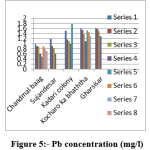 |
Figure 5: Pb concentration (mg/l) Click here to view figure |
Results shows that sample 17 has highest content of heavy metals which is collected from outside of a dye factory situated in Kadari coloy (Shriramsar). This factory drains its all contaminated water in nearby sewage naala. This contaminated water is used for agriculture purpose.
It is clearly showed that the metals concentrations are higher than the standard permissible limit. Except few samples, all samples are contaminated with excessive amount of heavy metals. So agricultural use of sewage water can affect productivity and quality of soil. Long term sewage irrigated crops consumption is very risky for health. Thus we have to be very careful about agricultural use of sewage water
So it is important to monitor the content of heavy metals in sewage water, irrigated soil and agricultural products regularly to minimize the harmful effects of lethal elements in edable agricultural products and prevent entering to food chain. If metal contaminated water is used for irrigation these metals accumulate in all parts of plants. Through consumption of metals contaminated vegetables these metals enter to the food chain and cause serious health problems for organism. In human brain and kidney disfunction occurs due to metals toxicity. Many authors also reported that long- term exposure of sewage irrigation is very risky for the human health 17. The results of the present study showed all sewage water samples contains very high ammount of heavy metals. Thus it is necessary to educate people about hazardous effects of sewage farming and government should implement proper guideline and rules related with sewage irrigation.
Acknowledgment
This research work did not receive any specific grant from funding agencies in the public, commercial, or not-for-profit sectors.
Conflict of Interest
The authors declare no confilict of interest.
References
- Yeole, S. N. Patil and N. D. Wagh, Journal of Environment, 2012, 1( 03), 84-92.
- Asati Ambika et al., International Journal of Application or Innovation in Engineering & Management, 2016, 5 (3), 56-66.
- Singh A., Sharama R. K., Agrawal M. and Marshall F. M., Food Chem. Toxicol., 2010, 48, 611-619.
- Akoumianakis K. A., Passam H. C., Barouchas P. E. and Moustakas N. K., Journal of food, Agriculture and Environment, 2009, 6, 206-209.
- Salvatore M.D., Carratu G. and Carafa A.M., Journal of food Agriculture and Environment, 2009, 7, 683-688.
- Choudhary R., Research Journal of Recent Sciences, 2012, 1, 352-353.
- Gupta S., Satpati S., Nayek S. and Garai D., Monit. Assess., 2009, Doi 10.1007/s 10661-009-0936-3.
- Singh A. and Agrawal M., Journal of Environmental Biology, 2010, 31 (5), 727-736.
- Chaolan Z., Zhongyi Li., Weiwei Y. Lipping P., Minghua G. and Dokyoung L., Bull Environ Contam Toxicol, 2013, 90, 736-741.
- Maheshwari, World Environ., 2008, 3 (1), 93-96.
- Alghobar M. A., Ramachandra L. and Suresha S., Env. Prot., 2014, 3 (5), 283-291.
- Bernard A., Indian J Med Res., 2008,128 (4), 557-64.
- Hoda A. A. Galal, American Journal of Environmental Protection, 2015, 3 (3), 100-105.
- Ahmad M. S., Ashraf M., Rev Environ Contam Toxicol., 2011, 214, 125-67.
- Aleksandra Duda-Chodak, Urszula B³aszczyk, Elementol., 2008, 13 (4), 685-696.
- Rolli N. M., Research Journal of Recent Sciences, 2014, 3 (IV C), 81-84.

This work is licensed under a Creative Commons Attribution 4.0 International License.









